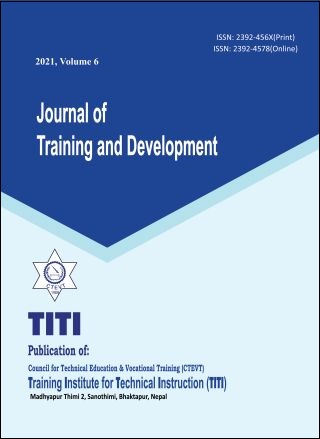Technology Integration Models and Frameworks in Teaching and Training
DOI:
https://doi.org/10.3126/jtd.v6i01.41674Keywords:
Cognitive load, Extraneous, Framework, Technology integration, TPACKAbstract
The purpose of this study is to review the existing models and frameworks which has been implemented for technology integration during teaching and training. As discussed in the numerous literature Technological Pedagogical and Content Knowledge (TPACK), Substitution, Augmentation, Modification, Redefinition (SMAR), TPACK-based ID models such as TPACK-Comprehension, Observation of instruction, Practice of instruction, and Reflection on TPACK (TPACK-COPR) model, Introduce-TPACK, Demonstrate, Develop, Implement, Revise - a TPACK-based lesson, and Reflect on a TPACK-based lesson (TPACK-IDDIRR1) model, and TPACK-IDDIRR2 model have been applied by today’s instructors and trainers to achieve the specific goal for effective teaching and training. This paper intends to highlight the key features of the above-mentioned models and frameworks with few hurdles as found in the empirical-based studies. It also discusses how those hurdles could be mitigated by addressing the extraneous cognitive load of instructors as well as trainers to carry out technology integration with future recommendations for the research. It was found that specific frameworks and models are limited to the macro-level concept but today’s instructors, as well as trainers, are required to have adequate instructional guidance in chronological steps so that they could implement those models and frameworks in their teaching and training for productive outcomes.
Downloads
Downloads
Published
How to Cite
Issue
Section
License
Copyright (c) 2021 Jiwak Raj Bajracharya

This work is licensed under a Creative Commons Attribution 4.0 International License.
Authors who publish with this journal agree to the following terms:
- Authors retain copyright and grant the journal right of first publication with the work simultaneously licensed under a Creative Commons Attribution License that allows others to share the work with an acknowledgement of the work's authorship and initial publication in this journal.
- Authors are able to enter into separate, additional contractual arrangements for the non-exclusive distribution of the journal's published version of the work (e.g., post it to an institutional repository or publish it in a book), with an acknowledgement of its initial publication in this journal.
- Authors are permitted and encouraged to post their work online (e.g., in institutional repositories or on their website) prior to and during the submission process, as it can lead to productive exchanges, as well as earlier and greater citation of published work (See The Effect of Open Access).




